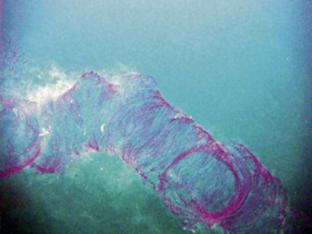Published in the Ocean Watch column, Honolulu Star-Advertiser © Susan Scott
June 20, 2011
Hawaii resident Suzanne Hammer snorkels daily around Hanauma Bay, rain or shine. One stormy Kona-weather day last month, she photographed a purple creature no one could identify.
“I was excited to finally get to take some photos of it,” she wrote, “as I had been trying to explain it to the Hanauma Bay educational volunteers for years while drawing pictures of it in the educational log.”
 Courtesy of Suzanne Hammer
Courtesy of Suzanne Hammer
Snorkeler Suzanne Hammer took this recent picture of siphonophores in Hanauma Bay.
Hammer sees this animal outside the reef about once a year, describing it as a jellylike cylinder about 6 to 7 feet long and as big around as a clothes-dryer duct. “It undulated like a dragon in a Chinese dragon dance.” One significant clue: The animal had stinging tentacles, some bunched up around the body like a fuzzy coat and others, 6 to 8 feet long, trailing behind.
Hammer verified that these were stingers by getting stung while trying to get close enough for photos.
When she sent me the pictures, I had the same reply as several others who saw them: I don’t know. I sent the photos to my friend David Hyrenbach, a marine biology professor at Hawaii Pacific University.
“Woaw!” he wrote back. “I will look in Brusca and Brusca, the super (invertebrates) book, and get back to you.”
Later that day David emailed, “How about a siphonophore? They pulsate and have stinging cells.” He included this excellent website, www.siphonophores.org/index.php, created by a researcher at Brown University.
The site doesn’t show Hammer’s animal, but it has photos of other weird jellylike creatures and the general description fits.
You might not think you know any siphonophores, but Hawaii’s swimmers, surfers and snorkelers know one a little too well: the Portuguese man-of-war.
We run into Portuguese man-of-wars because they float on the ocean’s surface, but another kind of siphonophore lives attached by its tentacles to the ocean floor. Most species, however, live in the dark ocean 2,000 feet to 3,000 feet below the surface (called midwater). There these remarkable predators eat fish and invertebrates that swim or drift into their lethal tentacles.
Siphonophores exist in mind-boggling sizes and shapes with characteristics that beg to be studied. One species has a pencil-thin body 130 feet long, making it the longest animal in the world. (Second is the blue whale, the longest recorded at 108 feet.)
Other siphonophores have red or orange digestive systems visible though transparent bodies. Some species glow green or blue when jostled.
Most siphonophores stay deep but sometimes, when the wind and currents are just right (or wrong if you’re a siphonophore), the creatures get driven to the surface.
Even so, it’s rare to see one because most fall apart at the slightest disturbance.
Collecting midwater siphonophores in nets, or even shining a research submersible’s light on some, often results in the animal breaking up into unidentifiable pieces. And like their Portuguese man-of-war relatives, siphonophores still pack a sting even when dead or damaged.
Because siphonophores are remote and fragile, researchers believe that the creatures’ numbers have been far underestimated. One hundred and seventy-five species are down there wiggling, glowing, luring and stinging in vast numbers. And those are the ones we know.
Woaw.